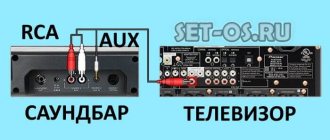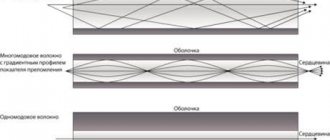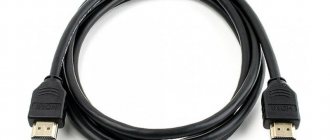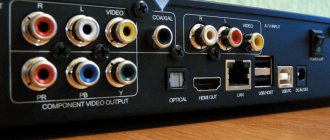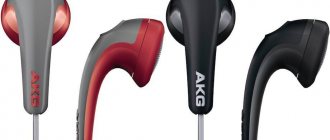Fiber-optic communication lines (FOCL) have served people for more than 40 years. Initially, such systems were used to transmit large volumes of digital information in computer global and local networks.
Fiber optic conductor
As technology developed, the quality of fiber optics increased and its cost fell. Already in the mid-80s of the last century, the first devices for transmitting audio signals via fiber-optic lines appeared. At the beginning of this century, optical cable for audio took a dominant position in the technology of high-quality transmission of audio signals.
Advantages of optical output
The main advantage of fiber optic audio transmission lines is the almost complete absence of sound distortion from electromagnetic fields, which are abundantly present in the human environment. Here, cables with metal conductors can noticeably lose to fiber optic systems in high-quality audio signal transmission. As a result, the speaker system will produce distorted sound.
In addition, when using an optical transmission channel, complete galvanic isolation between the transmitting and receiving devices is achieved. This also has a positive effect on the quality of audio signal transmission. Parasitic interference from bad ground buses is the scourge of audio equipment. The optical systems themselves do not create electromagnetic interference.
Types of fiber optic cable
Television cable: which one is better?
To send an audio signal over an optical channel, the sound is first converted into digital form, then, using an LED or solid-state laser, it is sent via an optical audio cable to the signal recipient - a photodetector.
Fiber optic conductors are divided into two main types:
- Monomode;
- Multimode.
In multimode light fluxes may have a spread in wavelengths and trajectories, which can lead to signal distortion over long conductor lengths. The light emitters in such sound transmission channels are LEDs, inexpensive and durable semiconductor devices. The length of the connectors does not exceed 5 meters. The diameter of the central light-conducting fiber is 62.5 microns. The outer shell of the light guide has a size of 125 microns.
For your information. The main advantage of multimode cable is its relative low cost, which is why it is widely used.
In a monomode conductor, light rays move rectilinearly, signal attenuation and distortion are minimal. The diameter of the light fiber is 1.3 microns, the signal wavelength is also 1.3 microns. Such a connector can be longer than a multimode connector. The light source in this case is a semiconductor laser, emitting signals with a strictly regulated wavelength. However, a laser is a more expensive and less durable device than an LED. As a result, the system becomes more expensive than a multimode system, although it has better parameters, in particular, the length of the conductor can be tens of meters.
Typical fiber optic cable design
Fiber Optic Cable Design
UTP cable
Optical fiber can be made from:
- Polymer;
- Quartz glass.
Polymer fiber is, as a rule, more resistant to mechanical stress and cheaper. However, over time it may lose transparency, which negatively affects the durability of the product.
Glass light guides have better optical characteristics, but are more expensive and fragile.
Advantages and disadvantages of fiberglass
Advantages:
- Glass optical cables can be used in high temperature applications such as furnaces, ovens and capacitors in large motors, as well as in extremely low temperature applications such as cold storage warehouses.
- Because glass cores are efficient at transmitting light and provide significantly higher transmission rates, glass optical fibers can be used over long sensing distances.
- Glass optical fiber allows you to use the photoelectric sensor in places where you wouldn't normally be able to use it. With this advantage, you can choose sensors with a wide range of housings, installation styles, and features to suit your specific application.
- Because glass optical fibers are thin and lightweight, they are optimized for small spaces and small objects.
Flaws:
- Installation of glass optical fibers requires highly skilled technicians, and the tools and equipment for fiber termination are typically expensive.
- The diameter of the fiberglass core is very small, hence it places higher technological requirements for connecting light to the core area such as light sources.
- Glass optical fibers become brittle and are more likely to break if handled incorrectly.
Comparison with HDMI
How to connect a TV cable
Fiber optic communication systems of the early 2000s have a serious competitor. These are devices for transmitting digital information, including an audio signal via an HDMI cable.
HDMI cable
HDMI (High Definition Multimedia Interface) is an interface for high-definition multimedia systems.
The big advantage of an HDMI connection is the ability to simultaneously transmit digital signals, both video and audio, in high quality. Moreover, sound can be sent over eight channels with 24-bit resolution and a frequency of 192 kHz. At the same time, surround sound is easily realized in the speaker system. The HDMI interface is superior to fiber optic systems in terms of the amount of transmitted audio information. For home use, HDMI cables have a length of 1.5-3 meters, but can reach 15 m.
The only disadvantage of an HDMI conductor is the signal transmission through metal conductors. Although they are well shielded, there is still potential for interference from local electromagnetic fields.
Will HDMI replace fiber optics? Not likely in the near future. Many acoustic systems and music centers using optical audio channels have been produced, and their production continues. The consumer will have to choose.
History of the system
Until recently, fiber optic cable was not perceived as a tool for high-quality sound transmission. It is known that fast data transmission is possible only with light. Optical technology was first used in the photophone developed by Alexander Bell.
Optical telephone communication proved the possibility of transmitting a signal through the air, but the inventor’s idea itself did not take root. The physicist's achievements began to be used for communication between ships, but nothing more.
The widespread use of fiber optic technologies began only in the mid-20th century, and a major breakthrough that brought digital audio out to the masses occurred in 1980 with the invention of fiberglass wire, which was capable of transmitting a light signal.
Despite the fact that the optical input celebrated its 40th anniversary, it is still considered the best in terms of analog sound transmission quality, which cannot be matched by the “tulip” HDMI cable, which appeared much later.
Fiber optic cable for audio devices
Almost all high-quality audio reproduction systems have an optical channel.
Digital audio transmission between remote devices follows the SPDIF (Sony*/Philips* Digital Interface Format) protocol. Its implementation in an optical version was made by Toshiba and became a generally recognized standard called TOSLINK.
Optical audio output
View of the optical digital audio cable of the TOSLINK system
For portable devices, such as laptops, smaller Mini TOSLINK connectors can be used.
Mini TOSLINK connector
Cable for home theater and TV
There are four main ways to connect the Home Theater speaker system to your TV:
- Electrical analog cable with “Tulip” connectors;
- Coaxial electrical cable;
- Fiber optics;
- HDMI connector.
Analog cable
Connecting with an analog electrical conductor is the simplest and most “ancient” method. You will need a two-channel connector with 2 + 2 Tulip connectors (RCA), two colors red and white.
Analog cable with Tulip connectors
Connect the analogue audio output of the TV “AudioOut” to the input of the home theater receiver “AudioIn”. The colors of the “Tulips” correspond to the colors of the receiver and TV sockets.
The quality of signal transmission with such a connection is low.
Coaxial digital cable
The best quality is achieved when using coaxial cable. The audio signal is transmitted digitally, according to the S PDIF protocol, via a shielded wire.
The cable connects the TV jack marked “COAXIALOUT” or “S/PDIF-OUTCOAXIAL” and the receiver “COAXIALIN” jack.
Attention! The connector must be connected in the correct direction to ensure proper transmission of the audio signal from the TV to the home theater. Directional markings are available on the product.
The sound quality is high, but there is a possibility of interference from electromagnetic fields.
Optical fiber
The optical audio cable connects to the jack on the TV marked Optical-Out or Out-Toshlink and the receiver's Optical-In or Toshlink-In jack.
Attention! When installing the optical connector, you should try not to bend it again or twist it in the longitudinal direction.
The quality of transmitted sound when using optical fiber is considered to be the best.
HDMI cable
To transmit a signal to a home theater, you must make sure that both the TV and the audio system support the ARC (Audio Return Channel) interface. Connection of the corresponding “HDMI-ARC” jacks of the TV and audio system is done using the HDMI connector version v 1.4, option “b”.
Connection is simple, the sound quality is no worse than that of an optical channel.
Basic operating principle
An optical cable connected to digital audio out consists of a shell and a core.
Accepted standards for TV input, the same for Samsung, LG, and other manufacturers, consist of several stages of information transportation:
- generation of a light signal from an electrical one;
- its retransmission from output to input without loss of power or distortion;
- reception of a signal by an incoming device;
- reverse transformation of the signal into an electrical one.
An optical cable connected to digital audio out consists of a sheath and a core. During production, attention is paid to the complexity of connecting connectors, with which you can connect two devices to each other.
Violation of technology significantly spoils the quality of transmitted sound, making the use of optical connections useless. That is why music lovers purchase industrial-cut cables of a certain length.
Optical cable parameters for a high-quality connection
When purchasing a fiber optic conductor, you should pay attention to the following factors:
- The cable length should be reasonably short. You should not buy a conductor 10 meters long if the connected devices are located at a distance of only 2-3 m. The margin here only harms - the price of the product increases, the likelihood of signal distortion increases, and therefore the quality of the acoustics.
- It is better to purchase an optical audio cable made of glass with a large number of fibers. It is desirable that the connector be thick enough; its protective shell is large and can protect the fibers from mechanical damage.
- The bandwidth of the optical connector must be at least 9 MHz, preferably 11 MHz.
- The connector must not have any traces of kinks or twists.
- The purchase should be made in a trusted place. The price of the conductor should be reasonably high. A cheap fiber optic adapter, also purchased from a dubious place, will lead to disappointment with the sound quality, if there is any sound at all.
Audio systems enjoy well-deserved recognition among audio professionals and audiophiles: all those for whom high-quality sound reproduction is the main factor in work, hobbies or just leisure.
What is the difference between fiberglass and plastic fiber?
From the introduction of glass optical fiber and plastic optical fiber below, you may have a clearer understanding of the difference between the two terms. The following comparison table that summarizes the options will help you understand this better.
| Element | Fiberglass | Plastic optical fiber |
| Core diameter | Narrower (about 50-100μm for multimode fiber and 8-10μm for single-mode fiber) | Wider (about 150-2000 μm and even up to 20000 μm) |
| Numerical aperture | More | More narrow |
| Price | Expensive | Cheaper |
| Signal strength | Poorer | Better |
| Extreme temperatures | Sustainable | Unsustainable |
| Flexibility | Less flexible | More flexible |
| Consumability | More complex | Easier |
| Transmission distance | Longer | Shorter |
POF is the best choice for short distance connections and for those who do not have professional fiberglass knowledge. For difficult conditions and higher transmission speeds over long distances, glass optical fiber should be used.
Other type of optical fiber
Another type of optical fiber is plastic clad silica (PCS) or sometimes called hard clad silica (HCS). It has a glass core and a plastic cladding, but is used less than plastic optical fiber. Compared to all-glass fibers, it has significantly lower performance characteristics, offering higher losses and lower throughput. The main advantage is the large core (up to 200-300 μm), which is beneficial in applications such as industrial and medical applications.

